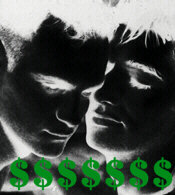 |


Report in Demography Magazine Confirms Research Four Academicians Agree in Separate Investigation |
|
Compiled By GayToday
 Washington, D.C.--A report in this month's issue of Demography on income levels
among same-sex partners further refutes the myth of "gay affluence," a
misconception that has been used to stereotype and discriminate against gay,
lesbian, bisexual and transgender (GLBT) people, the National Gay and Lesbian
Task Force said Friday.
Washington, D.C.--A report in this month's issue of Demography on income levels
among same-sex partners further refutes the myth of "gay affluence," a
misconception that has been used to stereotype and discriminate against gay,
lesbian, bisexual and transgender (GLBT) people, the National Gay and Lesbian
Task Force said Friday.
In 1998, the Policy Institute of the National Gay and Lesbian Task Force and the Institute for Gay and Lesbian Strategic Studies issued a joint study entitled Income Inflation: The Myth of Affluence Among Gay, Lesbian and Bisexual Americans. Many of the study's findings were confirmed by a separate, independent study by four academicians published in this month's issue of Demography. "As the real outline of economic life for gay, lesbian and bisexual people becomes more defined through these studies, we see that stereotypes portraying our communities as only rich are distorted," said Ingrid Rivera-Dessuit, coordinator of NGLTF's Racial and Economic Justice Initiative. "While the myth of affluence helps our communities gain the attention of powerful corporations, the real dangers lie in how the myths skew the political priorities of the movement and hurt our ability to advocate on issues of economic justice."
In that case, Supreme Court Justice Antonin Scalia cited misused market research statistics on gay and lesbian people when he wrote that "high disposable income" gave gay people "disproportionate political power," and that Colorado voters should be permitted to rein in that power by banning anti-discrimination protections for lesbian, gay and bisexual residents. Scalia's dissenting opinion in the Colorado Amendment 2 case was joined by Chief Justice William Rehnquist and Justice Clarence Thomas. Even when social science data provides a more accurate sketch of economic life for gay, lesbian, and bisexual people, it is argued that same-sex couples, even with lower individual earnings, would still have more discretionary income than a heterosexual couple. "The stereotype of gay or lesbian couples as 'DINKS' ('dual-income-no-kids') involves two assumptions," wrote Income Inflation author M.V. Lee Badgett, an economist at the University of Massachusetts. "First, that same-sex couples will have higher incomes than married couples, and second, that lesbian and gay men have no children." Further research on household incomes of same-sex couples by Badgett has demonstrated that heterosexual-couple households and male same-sex-couple households have roughly equal household incomes, while female same-sex couples bring home 18 to 20 percent less income. The economic picture for female same-sex households becomes more grim considering that at least 22 percent of lesbian couples living together have children, as reported by the Demography article. Other highlights from Income Inflation--many supported by the latest issue of Demography--include:
Another report by the NGLTF Policy Institute, entitled Out and Voting II, analyzes Voter News Service (VNS) exit poll data from 1990-1998. This report, authored by political scientist Robert W. Bailey, also indicated that gay, lesbian, and bisexual people earn, on average, less than others in the VNS sample. Report highlights from Out and Voting II include:
|

